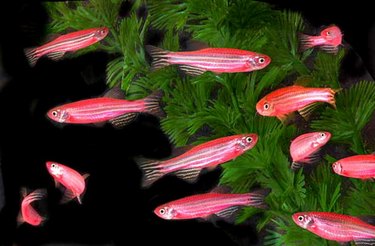
Most colors react to near-ultraviolet light in some way; blacklights simply make those fluorescent reactions visible by excluding the reactions from lower wavelengths. You don't have to look far to find phosphorescent and blacklight-reactive paint — the trick is apply them in a tasteful and interesting way that will allow your psychedelic space to truly transcend its boundaries.
A Change of Perpective
Video of the Day
Blacklights work by revealing the unseen, and that includes paints and pigments that are nearly invisible under normal light spectra. Forced perpective is a trick used by photographers and filmmakers to make things seem further away than they really are, and involves making objects intended to be "further away" smaller, lower in detail and drawn with thinner lines. You might consider creating a cathedral ceiling on your otherwise flat roof using blacklight-reactive paint, or painting a "hallway" around a window where one doesn't exist in normal light.
Video of the Day
The Art of Indirection
Blacklights work in part by photobleaching the rhodopsin in the rods of your eyes. Rhodopsin is the chemical that allows you to see in the dark and in the red color spectrum; photobleaching it with UV light will make blacklight-reactive paints seem more vivid by making everything else harder to see. This is something to bear in mind when mounting your light tubes. If you want your colors and paints to seem more vivid, mount the tubes where you can see them. If you just want to use a blacklight to add a bit of spice to the room while not blinding you, then mount it behind something and reflect its light off of a wall to disperse it.
Living Lights
A number of animals and plants react to blacklights in one way or another, and most of them live in the sea. Sea anemones fluoresce in a number of colors, and jellyfish fluoresce primarily in blue and pink. For a truly psychedelic experience, look into buying a school of GloFish. These genetically-modified zebrafish look like striped minnows in natural light, but their additional sea coral and sea anemone genes cause them to fluoresce in a bright orange, red and green under a blacklight. GloFish can look particularly stunning in a "tank wall," which is essentially two large, vertical panes of glass separated by about six inches of water. When illuminated by a blacklight, the fish will look as though they're swimming through thin air.
Flickering Effects
No matter how intricate your decor may be, it can get boring if it remains static. LED and incandescent blacklights can flicker on and off at will, but they're both very dim where the pure blacklight spectrum is concerned. Fluorescent lights are much brighter and more efficient, but they take time to illuminate and don't offer any adjustability in terms of brightness. You can add a bit of movement and dimension to your lighting arangement by using a motorized filter over your blacklight to shut it on and off very quickly or vary its brightness. If you don't want to build something completely custom, you can modify a desk or box fan by replacing its blades with a round sheet of Lexan. Mask half of the plastic disk off and spray paint the other half black. Place it in front of your light, set it on low and the light will flicker on and off.